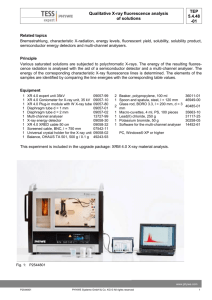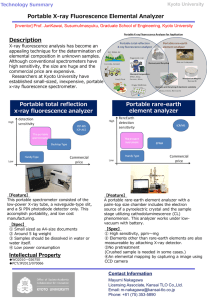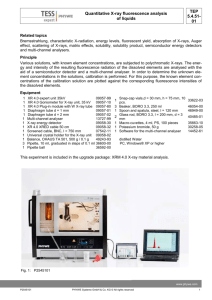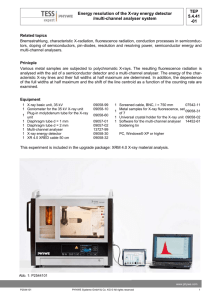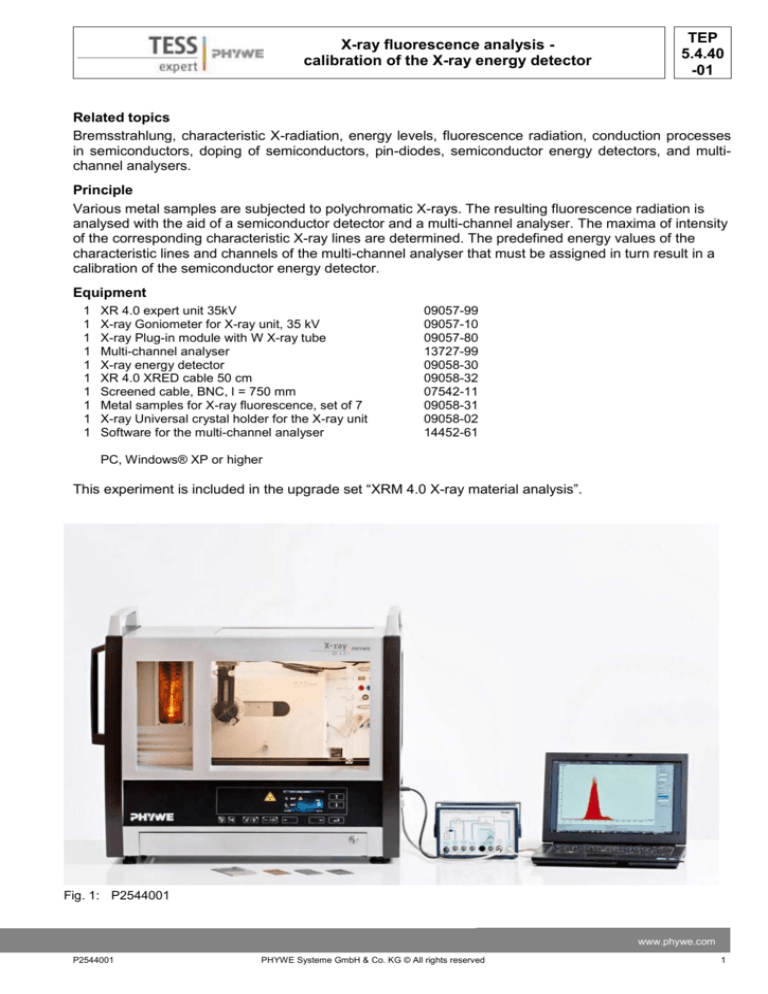
X-ray fluorescence analysis calibration of the X-ray energy detector
TEP
5.4.40
-01
Related topics
Bremsstrahlung, characteristic X-radiation, energy levels, fluorescence radiation, conduction processes
in semiconductors, doping of semiconductors, pin-diodes, semiconductor energy detectors, and multichannel analysers.
Principle
Various metal samples are subjected to polychromatic X-rays. The resulting fluorescence radiation is
analysed with the aid of a semiconductor detector and a multi-channel analyser. The maxima of intensity
of the corresponding characteristic X-ray lines are determined. The predefined energy values of the
characteristic lines and channels of the multi-channel analyser that must be assigned in turn result in a
calibration of the semiconductor energy detector.
Equipment
1
1
1
1
1
1
1
1
1
1
XR 4.0 expert unit 35kV
X-ray Goniometer for X-ray unit, 35 kV
X-ray Plug-in module with W X-ray tube
Multi-channel analyser
X-ray energy detector
XR 4.0 XRED cable 50 cm
Screened cable, BNC, l = 750 mm
Metal samples for X-ray fluorescence, set of 7
X-ray Universal crystal holder for the X-ray unit
Software for the multi-channel analyser
09057-99
09057-10
09057-80
13727-99
09058-30
09058-32
07542-11
09058-31
09058-02
14452-61
PC, Windows® XP or higher
This experiment is included in the upgrade set “XRM 4.0 X-ray material analysis”.
Fig. 1: P2544001
www.phywe.com
P2544001
PHYWE Systeme GmbH & Co. KG © All rights reserved
1
TEP
5.4.40
-01
X-ray fluorescence analysis calibration of the X-ray energy detector
Tasks
1. Record the spectra of the fluorescence radiation that is generated by the metal samples.
2. Determine the channel numbers of the intensity
maxima of the characteristic lines of the corresponding fluorescence radiation.
3. Represent the predefined line energies as a
function of the channel numbers in a graphical
form for two different gain factors of the multichannel analyser.
Set-up
- Screw the adapter ring onto the inlet tube of the
energy detector.
- Connect the signal and supply cables to the
corresponding ports of the detector with the aid
of the right-angle plugs.
Fig. 2: Connectors in the experiment chamber
- Connect the signal and supply cables to the
corresponding ports in the experiment chamber
of the X-ray unit. In Figure 2, the port for the
signal cable is marked in red and the port for
the supply cable is marked in green. Connect
the external X RED ports of the x-ray unit (see
Fig. 3) to the multi-channel analyser (MCA).
Connect the signal cable to the “Input” port and
the supply cable to the “X-Ray Energy Det.”
Fig. 3: Connection of the multi-channel analyser
port of the MCA.
- Secure the energy detector in the holder of the
swivel arm of the goniometer. Lay the two cables with sufficient length so that the goniometer can be swivelled freely over the entire swivelling range.
X-ray energy
detector
- Connect the multi-channel analyser and computer with the aid of the USB cable.
Procedure
- Insert the diaphragm tube with the 2-mmaperture.
- Bring the goniometer block and the detector to
their respective end positions on the left. Bring
the detector to the 90° position in the 2:1 coupling mode
- Insert the metal sample with the universal crystal holder (sample is at 45°).
- Operating data of the copper X-ray tube: Set
an anode voltage Ua = 35 kV and the anode
current so that the counting rate for each of the
ode current for the tin and silver samples).
2
Universal crystal
holder with metal
sample
End position of
the goniometer
on the left
Fig. 4: Goniometer set-up
PHYWE Systeme GmbH & Co. KG © All rights reserved
P2544001
X-ray fluorescence analysis calibration of the X-ray energy detector
-
-
TEP
5.4.40
-01
Confirm the operating data by pressing the “ENTER” button.
Lock the sliding door of the X-ray unit.
In the “measure” program, select “Multi-channel analyser” under “Gauge”. Then, select “Spectra recording”. Set “XData = channel number” and “Interval width [channels] = 1 channel”. Set the offset so
that low-energy noise signals will be suppressed (usually 5% are sufficient).
Gain = 2 (select gain level 4 for the second measurement series).
Measuring time: 3 minutes (5 minutes for the Ag sample). Use the timer of the X-ray unit for this purpose.
Note
A tin sample can be produced easily based on commercially available soldering tin for electronic applications. Melt a small bead of tin off the tin wire with the aid of a lighter or soldering iron and let it drop to the
floor. The resulting small “pancake” can be used as the sample. Fluorescence lines of the alloy components of the soldering tin will be ignored for the evaluation.
Theory
The energy analysis of X-rays with the aid of semiconductor detectors is described briefly based on the
example of a Si-pin-detector (p-contact - intrinsic - n-contact). Incident X-ray quanta with a sufficient level
of energy create free electrons in the Si crystal due to the photoelectric effect. The kinetic energy of
these electrons correlates with the energy of the X-ray quanta. Apart from the phonon excitation, the
electrons also create electron-hole pairs on their way through the depletion layer of the semiconductor.
The number of these electron-hole pairs is a measure of the energy of the incident quantum. Holes and
electrons are withdrawn by voltage that is applied externally and, thereby, create a charge pulse. The
magnitude of the charge pulse, on the other hand, is a measure of the energy of the incident X-ray quantum.
The resulting pulse height spectrum will then be analysed by a multi-channel analyser, in which various
pulse heights are assigned to different channels. Pulses of the same voltage level will be added up in the
same channel.
In a last step, an energy value must also be assigned to the pulse height (= channel number).
This energy calibration can be performed – as it is
done here – with the aid of the characteristic lines
and the known energy levels of the X-ray fluorescence radiation.
Kα
Evaluation
Evaluation of the measurement curves
- In order to determine the line position, switch
from the bar display to the curve display. To do
so, click “Display options” and then “InterpolaKβ
tion and straight lines”. Figure 5a shows the result concerning the spectrum of the zinc sam- Fig. 5a: Fluorescence spectrum of zinc, gain level 2
ple.
- Extend the relevant line section with the aid of
the zoom function .
-
Then, select the various curve sections with
“, open the window “Function fitting “. Then, select
“Scaled normal distribution“ (see Fig. 5b).
Hide the original measurement curve and reselect the sections of the normal distributions. Find the
line centroids of the normal distributions with “Peak analysis”
(see Fig. 5c) or determine them with
the function “Survey”
.
www.phywe.com
P2544001
PHYWE Systeme GmbH & Co. KG © All rights reserved
3
TEP
5.4.40
-01
X-ray fluorescence analysis calibration of the X-ray energy detector
Kα
Kβ
Fig. 5b: Fluorescence lines of zinc with a fitted normal distribution
Fig. 5c: Normal distribution of the zinc fluorescence lines for determining their
channel position (original measurement curve not shown)
Task 1: Record the spectra of the fluorescence radiation that is generated by the metal samples.
As an example of measurements with gain level 4 of the multichannel analyser, Figure 6 shows the fluorescence spectrum of a copper sample.
Task 2: Determine the channel numbers of the intensity maxima of the characteristic lines of the corresponding fluorescence radiation.
The following table shows the results of various spectra for two different gain levels of the analyser. The
values that are stated for the Kα lines are the mean
energy values of the Kα1 and Kα2 lines.
Since the X-ray unit can only supply radiation with a
maximum energy of 35 keV, analyses with gain level 1
of the multi-channel analyser are not useful in this Fig. 6: Fluorescence lines of copper with a fitted normal distribution, gain level 4.
case.
4
PHYWE Systeme GmbH & Co. KG © All rights reserved
P2544001
TEP
5.4.40
-01
X-ray fluorescence analysis calibration of the X-ray energy detector
Table: Relationship between the energy* and channel number
A
B
C
D
E
Gain level 2
Gain level 4
Element
Line
E / keV
Channel number
Channel number
Fe
Fe
Ni
Cu
Ni
Zn
Cu
Zn
Ag
Ag
Kα
Kβ1
Kα
Kα
Kβ1
Kα
Kβ1
Kβ
Kα
Kβ1
6.40
7.06
7.47
8.04
8.26
8.63
8.90
9.57
22.08
24.94
596
680
731
802
828
877
909
995
2595
2958
1402
1564
1671
1813
1857
1973
2027
2208
(* energy values from Handbook of Chemistry and Physics, CRC-Press, USA)
Task 3: Represent the predefined line energies as a function of the channel numbers in a graphical form
for two gain factors of the multi-channel analyser.
The table values of the energy of the fluorescence lines are shown in Figure 7 (gain level 4) and Figure 8
(gain level 2) as a function of the associated channel numbers that were determined during the experiment. In their mathematical form, the regression lines that are added help in precisely determining the
energy level of an unknown radiation based on the associated channel number. A line with the channel
number x, for example, has an energy of E = (0.00434 x +0.674) keV in accordance with Figure 7.
Fig. 7: Straight calibration line for gain level 4 of the multi-channel analyser
www.phywe.com
P2544001
PHYWE Systeme GmbH & Co. KG © All rights reserved
5
TEP
5.4.40
-01
X-ray fluorescence analysis calibration of the X-ray energy detector
Fig. 8: Straight calibration line for gain level 2 of the multi-channel analyser
6
PHYWE Systeme GmbH & Co. KG © All rights reserved
P2544001


